轮机英语习题翻译
轮机英语教材后315道翻译
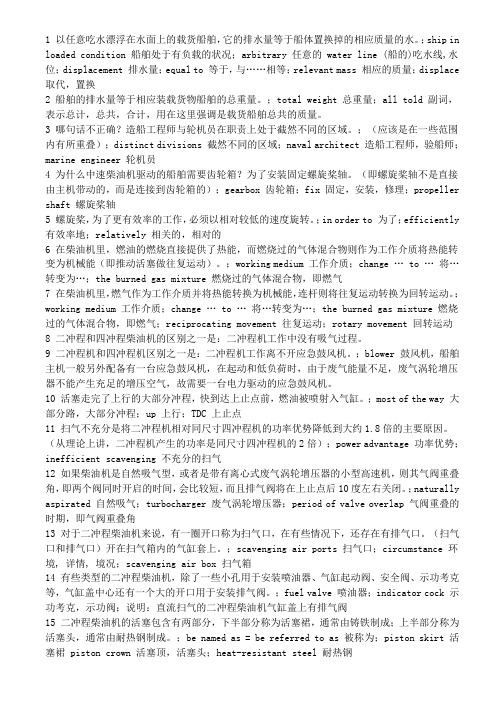
1 以任意吃水漂浮在水面上的载货船舶,它的排水量等于船体置换掉的相应质量的水。
;ship in loaded condition 船舶处于有负载的状况;arbitrary 任意的 water line (船的)吃水线,水位;displacement 排水量;equal to 等于,与……相等;relevant mass 相应的质量;displace 取代,置换2 船舶的排水量等于相应装载货物船舶的总重量。
;total weight 总重量;all told 副词,表示总计,总共,合计,用在这里强调是载货船舶总共的质量。
3 哪句话不正确?造船工程师与轮机员在职责上处于截然不同的区域。
;(应该是在一些范围内有所重叠);distinct divisions 截然不同的区域;naval architect 造船工程师,验船师;marine engineer 轮机员4 为什么中速柴油机驱动的船舶需要齿轮箱?为了安装固定螺旋桨轴。
(即螺旋桨轴不是直接由主机带动的,而是连接到齿轮箱的);gearbox 齿轮箱;fix 固定,安装,修理;propeller shaft 螺旋桨轴5 螺旋桨,为了更有效率的工作,必须以相对较低的速度旋转。
;in order to 为了;efficiently 有效率地;relatively 相关的,相对的6 在柴油机里,燃油的燃烧直接提供了热能,而燃烧过的气体混合物则作为工作介质将热能转变为机械能(即推动活塞做往复运动)。
;working medium 工作介质;change … to …将…转变为…;the burned gas mixture 燃烧过的气体混合物,即燃气7 在柴油机里,燃气作为工作介质并将热能转换为机械能,连杆则将往复运动转换为回转运动。
;working medium 工作介质;change … to …将…转变为…;the burned gas mixture 燃烧过的气体混合物,即燃气;reciprocating movement 往复运动;rotary movement 回转运动8 二冲程和四冲程柴油机的区别之一是:二冲程机工作中没有吸气过程。
最新-轮机英语关联题题库最新整理篇(带翻译)解析 精品
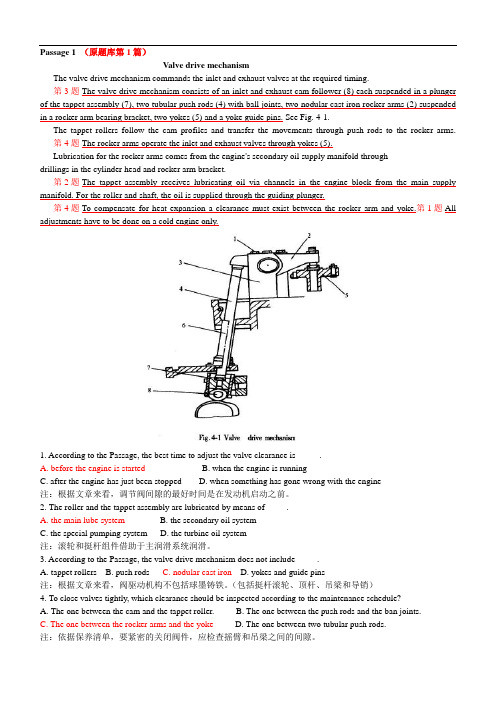
Passage 1(原题库第1篇)Valve drive mechanismThe valve drive mechanism commands the inlet and exhaust valves at the required timing.第3题The valve drive mechanism consists of an inlet and exhaust cam follower (8) each suspended in a plunger of the tappet assembly (7), two tubular push rods (4) with ball joints, two nodular cast iron rocker arms (2) suspended in a rocker arm bearing bracket, two yokes (5) and a yoke guide pins. See Fig. 4-1.The tappet rollers follow the cam profiles and transfer the movements through push rods to the rocker arms.第4题The rocker arms operate the inlet and exhaust valves through yokes (5).Lubrication for the rocker arms comes from the engine's secondary oil supply manifold throughdrillings in the cylinder head and rocker arm bracket.第2题The tappet assembly receives lubricating oil via channels in the engine block from the main supply manifold. For the roller and shaft, the oil is supplied through the guiding plunger.第4题To compensate for heat expansion a clearance must exist between the rocker arm and yoke.第1题All adjustments have to be done on a cold engine only.1. According to the Passage, the best time to adjust the valve clearance is _____.A. before the engine is startedB. when the engine is runningC. after the engine has just been stoppedD. when something has gone wrong with the engine注:根据文章来看,调节阀间隙的最好时间是在发动机启动之前。
轮机英语题库翻译
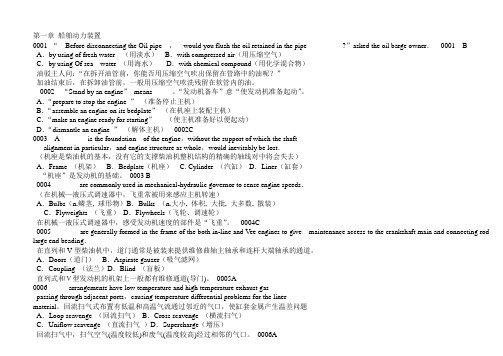
第一章船舶动力装置0001 “Before disconnecting the Oil pipe ,would you flush the oil retained in the pipe _______?”asked the oil barge owner.0001 B A.by using of fresh water (用淡水)B.with compressed air(用压缩空气)C.by using Of sea water (用海水)D.with chemical compound(用化学混合物)油驳主人问:“在拆开油管前,你能否用压缩空气吹出保留在管路中的油呢?”加油结束后,在拆卸油管前,一般用压缩空气吹洗残留在软管内的油。
0002 “Stand by an engine”means _____。
“发动机备车”意“使发动机准备起动”。
A.“prepare to stop the engine ”(准备停止主机)B.“assemble an engine on its bedplate”(在机座上装配主机)C.“make an engine ready for starting”(使主机准备好以便起动)D.“dismantle an engine ”(解体主机)0002C0003 A _______ is the foundation of the engine,without the support of which the shaftalignment in particular,and engine structure as whole,would inevitably be lost.(机座是柴油机的基本,没有它的支撑柴油机整机结构的精确的轴线对中将会失去)A.Frame (机架)B.Bedplate(机座) C. Cylinder (汽缸)D.Liner(缸套)“机座”是发动机的基础。
轮机英语听力与会话四版问答题带翻译
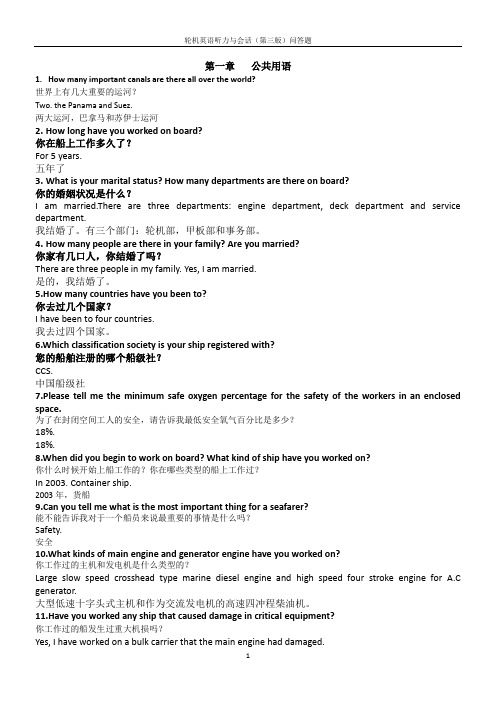
第一章公共用语1.How many important canals are there all over the world?世界上有几大重要的运河?Two. the Panama and Suez.两大运河,巴拿马和苏伊士运河2.How long have you worked on board?你在船上工作多久了?For 5 years.五年了3.What is your marital status? How many departments are there on board?你的婚姻状况是什么?I am married.There are three departments: engine department, deck department and service department.我结婚了。
有三个部门:轮机部,甲板部和事务部。
4.How many people are there in your family? Are you married?你家有几口人,你结婚了吗?There are three people in my family. Yes, I am married.是的,我结婚了。
5.How many countries have you been to?你去过几个国家?I have been to four countries.我去过四个国家。
6.Which classification society is your ship registered with?您的船舶注册的哪个船级社?CCS.中国船级社7.Please tell me the minimum safe oxygen percentage for the safety of the workers in an enclosed space.为了在封闭空间工人的安全,请告诉我最低安全氧气百分比是多少?18%.18%.8.When did you begin to work on board? What kind of ship have you worked on?你什么时候开始上船工作的?你在哪些类型的船上工作过?In 2003. Container ship.2003年,货船9.Can you tell me what is the most important thing for a seafarer?能不能告诉我对于一个船员来说最重要的事情是什么吗?Safety.安全10.What kinds of main engine and generator engine have you worked on?你工作过的主机和发电机是什么类型的?Large slow speed crosshead type marine diesel engine and high speed four stroke engine for A.C generator.大型低速十字头式主机和作为交流发电机的高速四冲程柴油机。
轮机英语会话评估问答题翻译
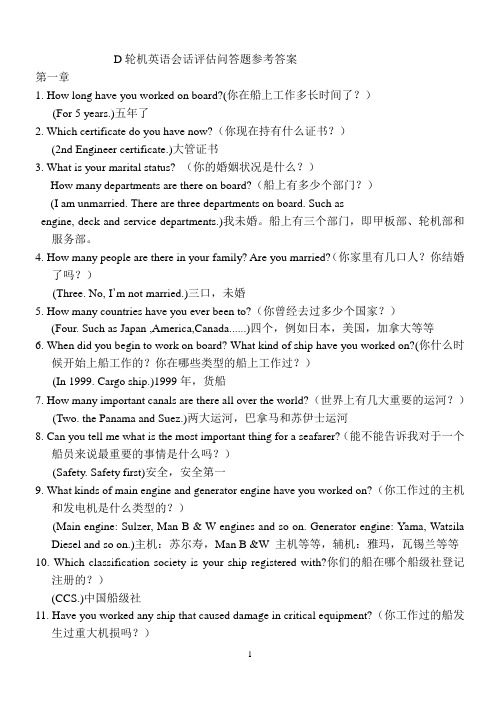
D轮机英语会话评估问答题参考答案第一章1. How long have you worked on board?(你在船上工作多长时间了?)(For 5 years.)五年了2. Which certificate do you have now?(你现在持有什么证书?)(2nd Engineer certificate.)大管证书3. What is your marital status? (你的婚姻状况是什么?)How many departments are there on board?(船上有多少个部门?)(I am unmarried. There are three departments on board. Such asengine, deck and service departments.)我未婚。
船上有三个部门,即甲板部、轮机部和服务部。
4. How many people are there in your family? Are you married?(你家里有几口人?你结婚了吗?)(Three. No, I’m not married.)三口,未婚5. How many countries have you ever been to?(你曾经去过多少个国家?)(Four. Such as Japan ,America,Canada......)四个,例如日本,美国,加拿大等等6. When did you begin to work on board? What kind of ship have you worked on?(你什么时候开始上船工作的?你在哪些类型的船上工作过?)(In 1999. Cargo ship.)1999年,货船7. How many important canals are there all over the world?(世界上有几大重要的运河?)(Two. the Panama and Suez.)两大运河,巴拿马和苏伊士运河8. Can you tell me what is the most important thing for a seafarer?(能不能告诉我对于一个船员来说最重要的事情是什么吗?)(Safety. Safety first)安全,安全第一9. What kinds of main engine and generator engine have you worked on?(你工作过的主机和发电机是什么类型的?)(Main engine: Sulzer, Man B & W engines and so on. Generator engine: Y ama, Watsila Diesel and so on.)主机:苏尔寿,Man B &W 主机等等,辅机:雅玛,瓦锡兰等等10. Which classification society is your ship registered with?你们的船在哪个船级社登记注册的?)(CCS.)中国船级社11. Have you worked any ship that caused damage in critical equipment?(你工作过的船发生过重大机损吗?)(Y es, I have worked on a cargo ship that the main engine had been damaged.)No, I served my job cautiously.是的,我工作过的货船主机损坏过12. How do you make your maintenance schedules?(如何制定你们的维修保养计划?)(It is based on ship’s planed maintenance sy stem and the machinery running hours records.)(它基于船舶计划维护保养体系和机器机械的运转时间记录)13. Could you list international conventions concerning marine shipping?(你能列举有关海运的国际公约吗?)(STCW, SOLAS, MARPOL, ISM Code and so on.)14. Could you tell the usages of the STCW convention?(你能谈谈STCW公约的用途吗?)(To provide standards of training, certification and watch keeping for seafarers.)(提供船员培训、发证和值班标准的国际公约。
《轮机英语》汉英互译

二、气缸 和气 缸盖
在扫气箱上部,每个气缸装有一个坚固的铸铁框架。这些框架称作气缸体或冷却水套,并
带有垂直法兰,与扫气箱一样,可用螺栓将各框架连成首尾两组。
基座、机架和气缸体用长贯穿螺栓连到一起,形成一个较大的坚实结构,减少了使用时产
生的变形及振动。
气缸套由铸铁制造,缸套表面有时镀铬。气缸套向下延伸到扫气箱。缸套与扫气箱顶部
当活塞上行到行程底部,即上止点(
时空气的压力和温度都上升到很高的数值。此时喷
油器把很细的油雾喷入炽热的空气中,燃烧开始,在气体中产生更高的压力。
随着高压气体的膨胀,活塞被推动下行「图
」直到它打开排气口,燃烧过的气体开始
排 出[ 图
,活塞继续下行直到它打开进气口,另一个循环开始。
在二冲程柴油机中,曲轴转一周产生一个动力行程,即做功行程;而在四冲程柴油机中,曲
使发动机活塞对曲轴做功,随之驱动螺旋桨. 两次 喷油期间 的运转过 程叫一个 工作循环 。它
由一些程序固定的过程组成。这个循环可在二个行程或四个行程内完成。四冲程柴油机的工
作循环需四个独立的活塞行程,即吸气、压缩、膨胀和排气。如果我们把吸气和排气行程与压
缩和膨胀行程结合起来,四冲程柴油机就变成了二冲程柴油机,如图
课文注释
机座在大多数情况下是焊接结构,用螺栓固定在构成船舶双层底的底座上。
该句为复合句,包含由
引导的两个定语从句,分别限制主语
和宾语
它在横向借助于侧楔垫螺栓,在纵向借助于端楔垫螺栓固定。 该句为并列句,由 连 接 。第二个分句省略了“
形机架顶部有一个结实的框架结构叫扫气箱。 该扫气箱分若干段,每段均带有垂直法
兰,通过螺栓可将它们在链传动装置前
缸的部分连成一体,链传动装置后
大管轮轮机英语新题
一、汉译英1、舵机的两套径向柱塞泵需检修,泵的滚珠轴承及全部密封圈如有必要需换新(备件由船上提供)。
检修中发现的其他损坏部件需修复或换新。
装复后在大管轮在场的情况下进行运转实验。
检修报告一式三份送交轮机长。
Two sets of radial piston pumps of the steering gear to be overhauled, if necessary, the ball bearings and all seal rings to be renewed with ship's spares. Any part if found damaged to be remedied or renewed. After refitted in order running test to be carried out in presence of second engineer. Reports for overhaul of pumps in triplicate to be handed over to chief engineer.2、舵机是船舶关键设备之一,其主要作用是控制船舶航向。
开航前,值班轮机员应会同值班驾驶员对舵,以确保船舶航行的安全。
驾驶台与舵机室的应急通讯系统也应保持良好工作。
The steering gear is one of the key important services in the ship and its main function is to control the ship's course. Prior to a ship's departure from any port the steering gear should be tested by duty engineer and duty officer to ensure the safety of a ship. The emergency communication system between the bridge and the steering gear compartment should also be kept in good order.3、请给船舶供应商写一物料订购单,要求供应商在“万华”轮10月5日离开新加坡之前供应下列物料:(1)石棉手套100双(2)直径50mm紫铜棒一根(2m长)(3)乙炔两瓶,15公斤/瓶(4)直径4mm不锈钢电焊条10公斤(5)燃油改良剂5桶,30升/桶Store Order ListMV. WanHuaPort of SingaporeOct. first, 2006 To: Shipchandler Co.Dear Sirs,Please supply our vessel MV. WanHua with the following stores prior to leaving Singapore on fifth, Oct.(1)Asbestos glove 100pcs(2)Copper stick 1pc, Φ50mm,2m in length(3)Acetylene 2btls, 15Kg/btl(4)Stainless steel electrode 10Kgs, Φ4mm(5)Improver for fuel combustion 5barrels,30litres/barrelThank you very much.Yours faithfullySigned by_________4、坞修时将螺旋桨轴抽出检查测量,并换新首尾密封装置的密封圈。
轮机英语书后新题+翻译
轮机英语书后新题翻译1.When a ship in loaded condition floats at arbitrary water line, its displacement is _______ to the relevant mass of water displaced by the ship.A. equalB. largerC. smallerD. equivalent答案A 以任意吃水漂浮在水面上的载货船舶,它的排水量等于船体置换掉的相应质量的水。
ship in loaded condition 船舶处于有负载的状况arbitrary 任意的water line (船的)吃水线,水位displacement 排水量equal to 等于,与……相等relevant mass 相应的质量displace 取代,置换2.The displacement of a ship is _______ to the total weight, all told, of the relevant loaded ship.A. largerB. equalC. smallerD. equivalent答案B 船舶的排水量等于相应装载货物船舶的总重量。
total weight 总重量all told 副词,表示总计,总共,合计,用在这里强调是载货船舶总共的质量。
3.Which one is not true?A. Two main areas of skill are involved in the construction of ship.B. There are distinct divisions in responsibilities between naval architects and marine engineers.C. Each ship will assume varying proportions according to its type.D. Ships can be divided into different categories from different perspectives.答案B 哪句话不正确?造船工程师与轮机员在职责上处于截然不同的区域。
轮机英语关联题题库整理91篇(带翻译)
Passage 1(原题库第1篇)Valve drive mechanismThe valve drive mechanism commands the inlet and exhaust valves at the required timing.第3题The valve drive mechanism consists of an inlet and exhaust cam follower (8) each suspended in a plunger of the tappet assembly (7), two tubular push rods (4) with ball joints, two nodular cast iron rocker arms (2) suspended in a rocker arm bearing bracket, two yokes (5) and a yoke guide pins. See Fig. 4-1.The tappet rollers follow the cam profiles and transfer the movements through push rods to the rocker arms.第4题The rocker arms operate the inlet and exhaust valves through yokes (5).Lubrication for the rocker arms comes from the engine's secondary oil supply manifold throughdrillings in the cylinder head and rocker arm bracket.第2题The tappet assembly receives lubricating oil via channels in the engine block from the main supply manifold. For the roller and shaft, the oil is supplied through the guiding plunger.第4题To compensate for heat expansion a clearance must exist between the rocker arm and yoke.第1题All adjustments have to be done on a cold engine only.1. According to the Passage, the best time to adjust the valve clearance is _____.A. before the engine is startedB. when the engine is runningC. after the engine has just been stoppedD. when something has gone wrong with the engine注:根据文章来看,调节阀间隙的最好时间是在发动机启动之前。
轮机英语题库译文
第一章船舶动力装置1 加油结束后,在拆油管前,一般用压缩空气吹洗残留在软管内的油。
2 “发动机备车”意“使发动机准备起动”。
3 “机座”是发动机的基础。
4 在机械一液压式调速器中,感应发动机速度的部件是“飞重”5 直列式和V型发动机的机架上一般都有维修通道(导门)。
6 回流扫气中,扫气空气(温度较低)和废气(温度较高)经过相邻的气口。
7 十字头销变椭圆了,需要光车。
8 联锁装置可用来防止在发动机换向完成前启动空气进入到气缸。
9 燃油和滑油在进入发动机之前,都需要经过处理。
“Both A and B”意“A和B两者都”;“neither A norB”意“既不是A也不是B”;“eight A or B”意“A、B两者之一”。
10 滑油用作活塞冷却的一个好处是漏到曲柄箱不会产生污染问题。
11 通过吹入新鲜空气去除废气的过程叫“扫气”。
A项意“气体交换”;B项意“充气”;D项意“增压”。
12 用作气缸和气缸头冷却的是淡水。
13 发动机运行过程中功率下降或失速的第一可能原因是轴承过热。
14 发动机曲轴失中可以通过测量臂距差来判断。
15 发动机A字架的顶部有扫气箱。
16 铝质活塞具有惯性小(重量轻)、热膨胀系数大的特点。
17 回流扫气式发动机中,扫气口和排气口布置在同一侧。
18 值班人员不能做任何影响其对主要机械和相关设备监视职责的工作。
19 气阀推杆间隙过小会引起排气阀过早打开、过晚关闭。
20 气阀推杆间隙过大会引起排气阀过晚打开、过早关闭。
21 与第20题重复。
22 选项中,较合理的答案只能是A。
更好的答案应该是“At the end of the compression stroke”。
意即“在压缩冲程结束时,气缸中有大量的空气并能燃烧大量的燃油”。
23 增压压力愈高,发动机发出的功率也就愈大。
24 与第8题重复。
25 燃油喷射泵没有在正确调定,引起发火过早或过晚。
26 与第17题重复。
27 (燃油)调节杆没有在正确的位置,以致太多的燃油供应到相应的气缸中去了。
- 1、下载文档前请自行甄别文档内容的完整性,平台不提供额外的编辑、内容补充、找答案等附加服务。
- 2、"仅部分预览"的文档,不可在线预览部分如存在完整性等问题,可反馈申请退款(可完整预览的文档不适用该条件!)。
- 3、如文档侵犯您的权益,请联系客服反馈,我们会尽快为您处理(人工客服工作时间:9:00-18:30)。
1. 当船舶载货浮于水面时,其排水量等于船舶所排开的水的重量。
2. 船舶排水量等于装载船舶的总重量。
3. 造船工程师和轮机工程师在某些方面的职责有重合。
4. 中速柴油机驱动的船舶需要采用减速齿轮箱来装配螺旋桨。
5. 为了有效工作,螺旋桨必须在较低的速度下运转。
6. 柴油机中,燃油的燃烧直接提供热能;燃气混合气作为工作介质,将热能转变为机械能。
7. 柴油机中,燃气混合气作为工作介质,将热能转变成机械能;连杆将往复运动变成回转运动。
8. 二冲程机和四冲程机的一个区别是二冲程机没有吸气冲程。
9. 二冲程机和四冲程机的一个区别是二冲程机没有鼓风机不能工作。
10. 柴油机中,当燃油喷入汽缸时,活塞已经上行运动经过了行程的大部分,几乎要到达上止点。
11. 扫气不充分是使二冲程机相对于同型的四冲程机的功率优势降低到1.8倍的主要原因。
12. 如果柴油机是自然吸气式或是一个带离心增压器的小型高速机,其气阀重叠期,即两阀都打开的时间,会短些,排气阀在上止点后10°关闭。
13. 二冲程柴油机的在扫气箱内的缸套上,有一串开口叫扫气口,在某些情况下,还有一些开口叫排气口。
14. 在某些二冲程柴油机中,缸盖上除了有一些小开孔安装燃油阀、起动阀、安全阀、示功阀等等之外,在缸盖中心有一个大的开孔,用于安装排气阀。
15. 在二冲程机中,活塞由上下两部构成,下部叫活塞裙,通常由铸铁制成;上部叫活塞头,由耐热钢制成。
16. 为了在汽缸磨合期保持住缸套上的油膜,活塞环的上下外缘都稍有倒角。
17. 为了控制热应力,某些类型的柴油机活塞使用薄壁结构和强化冷却。
18. 为了改善十字头轴承的工作状况,在最近的设计中减小了轴承压力,提高了圆周速度。
19. 当加热重油使其粘度达到10-15cst时,将会产生沸腾和气穴。
为了避免这一点,在多数情况下使用加压系统。
20. 来自燃油柜的燃油在进入日用柜前必须经过分油机处理,然后进入供油系统。
21. 5um全流通滤器应尽可能靠近主机安装,以保护主机喷油系统的组件。
22. 用于向副机提供柴油的增压泵应当可以由压缩空气或应急电源驱动。
23. 固体杂质会损坏燃油泵、喷油器、缸套、排气阀座和增压器叶片。
24. 作为传统海水冷却系统的一种替代形式,中央冷却系统在冷却器位置、液流控制和系统预热方面基于相同的原理,只是附加了一个中央冷却器和一套泵。
25. 在除气柜和膨胀柜之间安装的报警器能向值班船员报告主机的故障。
26. 中央冷却系统需要最少量的维护工作,因为这种系统只有一个设备与海水接触。
27. 关于缸套冷却水,副机的冷却水泵由主机驱动,而主机则有一个独立的冷却水泵。
28. 为了维持主机缸套水出口温度保持在80-85°之间,在缸套水出口装有一个三通阀以控制通过冷却器的冷却水流量。
29. 在现代装备中,主机和备用副机保持在恒定的温度下,不用预热即可启动。
30. 船用柴油机依靠向汽缸中供入高压空气来启动。
31. 船舶柴油机的启动空气系统通常有连锁装置,以避免在某些异常情况下启动。
32. 在启动系统中,自动阀由控制空气控制,汽缸启动阀也由控制空气控制。
33. 当活塞刚过上止点时,启动空气开始进入汽缸。
34. 启动主机时,压缩空气进入汽缸时,相应的活塞处于动力行程。
35. 主机启动达到足够高的转速后,例如20rpm,启动空气切断,燃油喷入汽缸。
36. 空气分配器通常由凸轮轴驱动,按一定的顺序将启动空气分配到各缸。
37. 提高燃烧效率不是滑油的功能。
38. 大型十字头式柴油机一般有两个润滑系统:供给汽缸润滑的全消耗系统和用于润滑运动机构及冷却活塞的循环系统。
39. 在某些柴油机的设计中,汽缸油是定时注入的,在活塞上行时注油,且只注射到活塞环带上。
40. 大型十字头式柴油机一般有两种润滑系统,汽缸油系统独有的功能是密封作用。
41. 大型十字头式柴油机一般有两种润滑系统,曲柄箱油系统独有的功能是冷却作用。
42. 使用劣质冷却油将使其性能恶化,在活塞冠上形成沉积物,从而导致热传递大幅度下降,产生过热和热裂。
从句子可知,过热和热裂的主要原因是使用劣质油。
43. 换气是内燃机循环的一个基本部分,是指新鲜空气的供入和废气的排出。
44. “在大多数现代柴油机中,使用废气涡轮增压实现空气密度的增加。
在废气涡轮增压器中,由柴油机废气驱动的涡轮机刚性连接到离心式空压机。
”从此句得知,空压机提高了空气密度,涡轮机叶轮直接带动压气机。
45. 当增压空气接触到汽缸和活塞,和残余废气混合后,它的温度将升高。
46. 在重叠期间穿过汽缸的空气所产生的冷却效果是有益的。
47. 在低速二冲程机中,当进气阀被下行活塞打开时,新鲜空气进入汽缸;当进气阀被上行的活塞关闭时,空气停止进入汽缸。
48. 缸套水用于大型柴油机启动前暖缸。
49. 在主机启动前,不用检查海水温度。
50. 当车钟的方向手柄移动时,凸轮轴和曲轴的相对位置随之相应改变。
51. 积碳会影响燃油的喷射雾化。
52. 燃油的沥青过多会在喷油器的喷嘴处形成积碳。
53. 传动系统将动力从主机传递到螺旋桨上,它由轴、轴承和螺旋桨组成。
54. 推力块将螺旋桨的推力传递到船体。
57. 螺旋桨由一个桨毂和桨毂上的多个螺旋形桨叶组成。
59. 传统喷油系统中,喷油压力在某种程度上随主机转速而波动;而在共轨柴油机中,喷油压力不受转速影响。
60. 在共轨柴油机中,燃油喷入汽缸前,存储于共用的燃油管中。
61. 在共轨柴油机中,由信号控制打开电磁阀,将燃油喷入汽缸。
62. 共轨柴油机用一台或两台高压油泵给所有的汽缸供油,另外还有一个备用泵;而传统柴油机的每个缸都有一个单独的高压油泵。
63. 共轨柴油机只有一台或两台高压油泵同时工作,可以更精确灵活地控制各缸的喷油。
64. 共轨柴油机在燃烧性能方面显示了巨大的优势,特别是在低速和低负载的情况下尤为明显。
65. 为了满足市场的要求,船用柴油机不能体积太大。
66. 主机改成电子控制的主要目的不是满足高转速的要求。
67. 如果凸轮控制的主机在额定转速下喷油压力正常,低速时的喷油压力会降低一些。
68. 如果无凸轮轴的主机在额定转速下喷油压力正常,低速时的喷油压力也会完全不变。
69. 具有更短的大修周期不是电控主机的特点。
70. 电控主机使用液压动力系统取代了机械式排气阀操纵系统。
78. 防止锅炉中的水倒流入供水管的阀叫做供水止回阀。
84. 吹灰器应按合理步骤使用,将烟灰吹向上升烟道。
85. 接班时,锅炉检查的第一项是查看锅炉水位。
86. 炉膛耐火材料的主要作用之一是避免炉膛热量损失过多。
95. 当热负荷开始增加时,膨胀阀的针阀会开大。
96. 当制冷需求量减小时,膨胀阀会开小。
97. 恒温阀有节流作用,就是说该阀能使制冷剂的压力下降。
98. 热力膨胀阀与离开盘管时的蒸汽过热度相对应(根据过热度调节其开度)。
99. 热力膨胀阀的温包安装在蒸发器盘管出口附近。
101. 电磁阀可以被归类为磁性截止阀。
102. 关于压缩机中的制冷剂压力和温度,发生的主要变化是制冷剂压力和温度都上升。
103. 冷凝器中的R-12过冷的目的是防止液体闪发。
104. 制冷系统冷凝器顶部的放气阀的作用是清除任何可能积聚在系统中的空气。
105. 压缩机上用于低压控制和高压切断的设备叫压力控制器。
106. 锌板安装在冷凝器的海水侧。
107. 制冷系统中的空气或不可凝性气体通过放气阀除去。
110. 如果氟利昂系统的管子接头没有使用垫圈,接头必须是研磨接头。
114. 安全阀安装在压缩机排出侧。
116. 沉淀过滤器安装在主阀和膨胀阀之间(防止杂质堵塞膨胀阀的节流孔)。
120. 向空气中加入水分以提高相对湿度的过程叫加湿。
121. 空调系统中包含冷却盘管和滤器的主配风管道叫总管。
122. 在离心式氟利昂制冷系统中,可以通过提高压缩机速度增加系统的总制冷量。
123. 大气中的湿度可以用(干湿球)湿度计测量。
124. 安装在压缩机吸入管路中,用于防止热气融霜时液体进入压缩机的装置叫做回热器。
125. 离心式压缩机的除气回收装置(净化装置)用于除去空气同时不损失冷剂。
126. 生活污水不是舱底水的组成部分。
127. 当舱底水在储存柜中加热时,不正确的叙述是:高温对分离舱底水中的乳化油不起作用。
128. 排放舱底水时,必须遵守国际的、国家的和当地的要求。
129. 横流膜过滤可以用于处理乳化油。
130. 能够满足MEPC 107(49)高于MEPC60(33)的要求的油水分离器的优点是分离乳化油的能力更强。
131. 有助于舱底水中油的乳化的方法是多使用溶剂。
132. 重力分离不能用于分离舱底水中不可分离性乳化油。
133. 除了粉碎或研磨过的食物残渣外,各类垃圾均不能在特殊海域排放。
134. 当垃圾中混合一些排放处理要求不同的排放物时,应执行最严格的要求。
136. 是细菌将生活污水中的有机物转变成化学性和生物性都不活泼的泥渣(惰性污泥),从而降低了生化需氧量。
137. 活在有氧环境中的细菌叫好氧菌。
138. 厌氧菌将生活污水转变成惰性泥渣时,不需要氧气。
139. 燃油和滑油进入主机前都需要处理。
140. 燃油处理包括储存(沉淀)、加热、过滤和离心分离。
141. 离心机用于分离两种液体或一种液体和其中的固体,如污油。
144. “离心机包括一台电动机驱动立轴,其顶部装有分离筒组件。
”从此话可知,分离筒组件安装在立轴的顶部。
145. 分离筒上下部各自独立的离心机通过自动将上下部分离进行排渣。
146. 分水机排渣前,停止进油,注入冲洗水。
147. 闪发式造水机将加热的海水排入一个腔室,这个腔室中的压力低于进入腔室的热海水的蒸发压力,由此产生的闪发水蒸汽随后被冷凝。
148. 闪发式造水机的闪发装置的设计极为重要,因为它必须提供最适宜的给水雾化状态以促进闪发过程,同时还必须维持相邻两级之间的压差。
149. 不能为闪发式造水机制造真空的是:离心泵。
150. 闪发式造水机和潜管式造水机的不同点在于前者通过压差使水蒸发。
151. 闪发式造水机的海水加热器需要维持一个足够低的温度使结垢减到最少。
152. 闪发式造水机的除雾器位于冷凝器之前。
166. 当系泊设备断电时,只有刹车过载,才能放出缆绳;只有手动操作,才能收入缆绳。
167. 在自动绞缆机中,缆绳在预设最大张力时放出,在张力较小时收回。
168. 正齿轮传动绞缆机比蜗轮传动的优点是反转时齿轮组的效率更高。
171. 变量泵的倾斜盘(swash plate)的另外一个名字叫做倾斜片(tiltable disc)。
175. 电压240伏、电阻8欧,电流是30安培。
177. 交流发电机的输出电压通过改变直流砺磁电压控制。
178. 发电机的电刷交错设置以避免整流器磨损不均匀。
